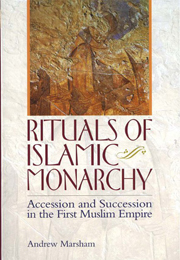Book contents
- Frontmatter
- Contents
- List of maps and figures
- Acknowledgements
- Map 1
- Map 2
- Map 3
- INTRODUCTION
- PART I LATE ANTIQUE ARABIA AND EARLY ISLAM (c. 550–c. 660)
- INTRODUCTION
- 1 ALLIANCE AND ALLEGIANCE IN PRE-ISLAMIC ARABIA
- 2 THE VERB BĀYAcA IN THE QURɔĀN: ALLEGIANCE TO MUḤAMMAD
- 3 THE OATH OF ALLEGIANCE IN THE ‘CONQUEST SOCIETY’ (c. 628–c. 660)
- PART II THE UMAYYAD CALIPHATE (c. 660–750)
- PART III THE EARLY ABBASID CALIPHATE (c. 750–809)
- PART IV THE MIDDLE ABBASID CALIPHATE (809–865)
- CONCLUSION
- Genealogical table of Quraysh
- Genealogical table of the Abbasid caliphs
- Bibliography
- Index
2 - THE VERB BĀYAcA IN THE QURɔĀN: ALLEGIANCE TO MUḤAMMAD
from PART I - LATE ANTIQUE ARABIA AND EARLY ISLAM (c. 550–c. 660)
Published online by Cambridge University Press: 05 September 2013
- Frontmatter
- Contents
- List of maps and figures
- Acknowledgements
- Map 1
- Map 2
- Map 3
- INTRODUCTION
- PART I LATE ANTIQUE ARABIA AND EARLY ISLAM (c. 550–c. 660)
- INTRODUCTION
- 1 ALLIANCE AND ALLEGIANCE IN PRE-ISLAMIC ARABIA
- 2 THE VERB BĀYAcA IN THE QURɔĀN: ALLEGIANCE TO MUḤAMMAD
- 3 THE OATH OF ALLEGIANCE IN THE ‘CONQUEST SOCIETY’ (c. 628–c. 660)
- PART II THE UMAYYAD CALIPHATE (c. 660–750)
- PART III THE EARLY ABBASID CALIPHATE (c. 750–809)
- PART IV THE MIDDLE ABBASID CALIPHATE (809–865)
- CONCLUSION
- Genealogical table of Quraysh
- Genealogical table of the Abbasid caliphs
- Bibliography
- Index
Summary
Throughout the Islamic tradition (that is, in texts composed in the eighth and ninth centuries and after) the verb bāyaca is used to describe the taking or giving of the pledge of allegiance to the leader of the Muslims (whence the noun, bayca, ‘pledge of allegiance’). This use of a quranic word is one instance of the numerous examples of Prophetic practice assuming the status of kerygma in the Islamic tradition. In this respect, the invention of the bayca as the means of recognising religio-political authority in the early Muslim community in some ways resembles the invention of the office of the caliphate itself, and the consultative process by which it was widely held that its incumbent should be chosen. Both the title ‘caliph’ (khalīfa) and the ‘consultation’ in choosing him (shūrā) appear to have been derived from quranic usages that suited, though did not anticipate, such institutions. Where bāyaca differs from khalīfa and shūrā is that it appears to have been not only, like khalifa and shura, something of a genuine continuation of Arabian custom but also a custom actually used by the Prophet Muḥammad, albeit subsequently modified and reimagined in response to new situations; Muḥammad does not seem to have anticipated caliphs, nor the method of selecting them, but he had taken pledges of loyalty from his followers, as the first caliphs did from theirs.
- Type
- Chapter
- Information
- Rituals of Islamic MonarchyAccession and Succession in the First Muslim Empire, pp. 40 - 59Publisher: Edinburgh University PressPrint publication year: 2009



